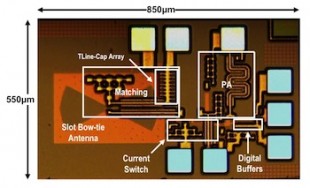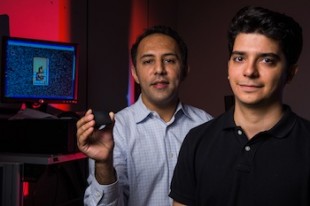 Keck Foundation grant to Rice University bolsters cutting-edge research for communications, imaging
Keck Foundation grant to Rice University bolsters cutting-edge research for communications, imaging
Rice University scientists have received a grant to develop terahertz-based technology that could enable a dramatic advance in wireless communications and other disciplines.
The $1 million grant by the W.M. Keck Foundation will let them tackle some of the knotty problems barring them from using the largely untapped terahertz region of the electromagnetic spectrum. Rice will supplement the grant with a $1.5 million commitment.
Potential benefits include much faster cellphone networks as well as sensors and detectors that may revolutionize medical imaging, security screening and manufacturing quality control.
Terahertz waves, which occupy the band from about 1 millimeter to 100 micrometers, are unique in the spectrum because few have figured out how to bend them to their purposes, said Daniel Mittleman, a professor of electrical and computer engineering and principal investigator on the project.
Longer waves power microwave ovens and radar; shorter waves include infrared and ultraviolet light, the visible spectrum and X-rays. While they don't pass easily through water, or even travel long distances in the atmosphere, many non-metallic materials are transparent to terahertz. This unique feature opens the door for many interesting applications, such as detecting chemicals and hidden explosives.
 "Terahertz technologies have been on the horizon for a long time, but people have only been thinking about specific applications seriously for a few years," Mittleman said. "But there is such potential. For example, there are famous diagrams that show that the demand for wireless bandwidth is growing exponentially, and that six or eight years from now we'll need tens or maybe 100 gigahertz of bandwidth. We're nowhere near that now with existing wireless networks (which use a part of the spectrum well below terahertz frequencies)." Current phones only achieve hundreds of megabits per second even under the most ideal conditions, he said.
"Terahertz technologies have been on the horizon for a long time, but people have only been thinking about specific applications seriously for a few years," Mittleman said. "But there is such potential. For example, there are famous diagrams that show that the demand for wireless bandwidth is growing exponentially, and that six or eight years from now we'll need tens or maybe 100 gigahertz of bandwidth. We're nowhere near that now with existing wireless networks (which use a part of the spectrum well below terahertz frequencies)." Current phones only achieve hundreds of megabits per second even under the most ideal conditions, he said.
"If you want a higher data rate, you have to go to a higher carrier frequency. But almost all of the frequencies above what we use now are already claimed by someone and regulated," he said.
Until you get up into the terahertz range. The band between microwave and infrared offers a wide-open frontier, and a unique collection of talent at Rice is eager to explore it, Mittleman said. "We have some innovative approaches, and the combination of expertise we have is fairly unusual," he said.
Co-investigators on the project are Junichiro Kono, a professor of electrical and computer engineering and of physics and astronomy; Edward Knightly, a professor of electrical and computer engineering and of computer science; and Aydin Babakhani, an assistant professor of electrical and computer engineering.
Mittleman's research centers on devices like a terahertz version of Rice's single-pixel camera and metamaterials that offer the possibility of high-speed modulation of terahertz beams. Kono specializes in the creation of advanced terahertz detectors that take advantage of Rice's unique position as a world leader in carbon nanotechnology. Knightly, as director of Rice's Wireless Networks Group, is a pioneer in the development of new wireless technologies. And Babakhani, director of the Rice Integrated Systems and Circuits laboratory and a winner of a DARPA Young Faculty Award in 2012, designs millimeter-wave and terahertz integrated circuits and antennas for communications, radar, medical imaging and biosensing.
Terahertz signals can help identify substances from the way they interact with the beams, but the beams themselves don't travel as far in air as microwave signals. And there are other problems, primary among them the lack of a powerful, portable and practical source of terahertz.
The Rice team expects to chip away at those problems. Babakhani and his team have already developed a silicon-based microchip that puts out the shortest pulse ever generated by such a device, an 8-picosecond impulse radiator that won the best paper award at the recent IEEE International Microwave Symposium. While it's not in the terahertz range, it could get there with the assistance of graphene, said Mittleman, who also serves as director of Rice's Richard E. Smalley Institute for Nanoscale Science and Technology.
"Aydin thinks the power can scale," he said. "We want to combine what Jun has done with the optical nonlinearities of graphene to frequency-double or triple it up to the range we need."
Small, fast, inexpensive chips that can not only send and receive terahertz beams but also steer them are necessary for future wireless applications, Mittleman said. "We're going to need lots of them, on the order of 100,000 of them to cover a city the size of New York, as opposed to the several thousand cell towers they use now."
Babakhani's speck-sized chips hold the key to steerable terahertz beams. "We've already demonstrated beam steering with two chips about 10 centimeters apart," he said. "The timing synchronization between them is almost perfect. Now we're looking at combining a signal from many chips with timing accuracy of a couple of hundred femtoseconds." A femtosecond is one millionth of one billionth of a second.
Wireless terahertz communications would require new and smarter network architecture. Current cellular systems have to imperceptibly switch between users to keep the signals from interfering with each other, Knightly said, but that will no longer be an issue in a network that sends data through a narrow beam that tracks the user.
"With terahertz, we'll have to coordinate distributed antennas, users and highly directional links, all wirelessly. This is a true paradigm shift requiring us to rethink the basic principles of wireless networking." Knightly said.
Leaping the hurdles associated with wireless will help the team on other projects that require strong, dependable terahertz sources and detectors. Mittleman's experience with the terahertz single-pixel camera and Kono's carbon nanotube-based detectors hint at the possibility of multispectral terahertz imaging. A super spectrometer would be particularly useful for security screening of people and containers.
Kono's successful efforts to detect and manipulate terahertz using graphene and carpets of nanotubes has inspired visions of many potential applications, he said. "Several pieces of the terahertz puzzle have reached a moderate level of maturity, but these pieces have emerged from diverse disciplines ranging from material science to optoelectronics to signal processing. The ultimate goal of our research is to fully eliminate the terahertz 'technology gap.'"
Kono said the researchers intend to develop materials and build devices, but also aim to deepen their understanding of the physics and chemistry at the boundaries of electronics and optics.
"The great thing about the experimental capabilities we have right now is that, in terms of spectrum, we're attacking the problems from above and below," Knightly said. "Below terahertz are millimeter wave and 60 gigahertz technologies, and we have experimental state-of-the-art devices at those frequencies in our labs.
"From above, we have prototypes in the visible light range that, from a networking point of view, have characteristics like line-of-sight and short range in common with terahertz. With these and other fundamental advances, we're very well positioned to realize our goals."


























































































